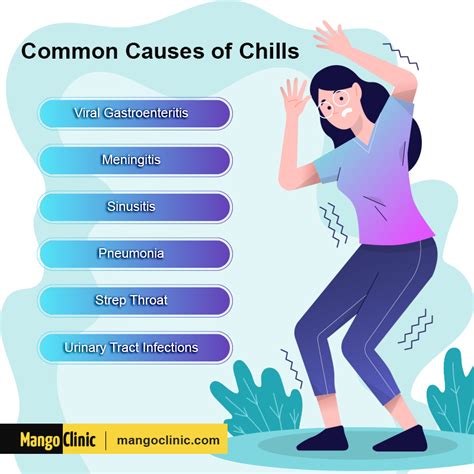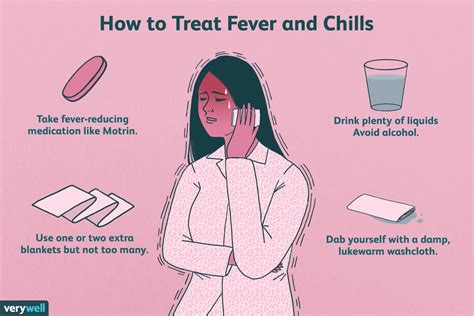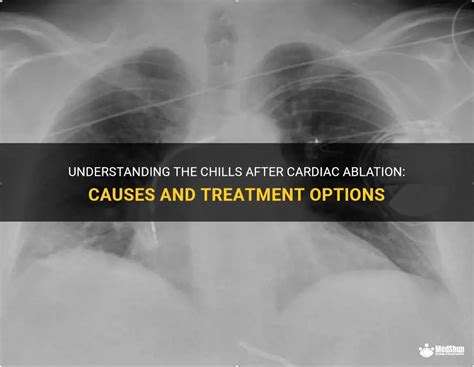Intro
Discover the causes of chills without fever, including infections, anxiety, and hypothyroidism, and learn how to manage and treat this symptom, also known as cold stress or idiopathic chills, to regain comfort and overall well-being.
Chills are a common symptom that can occur with or without a fever. When you experience chills without a fever, it can be unsettling and leave you wondering what's causing it. Chills are essentially a sensation of coldness, often accompanied by shivering or shaking, and can be a precursor to a more serious condition or a standalone issue. Understanding the reasons behind chills without fever is essential to address the underlying cause and find relief. In this article, we'll delve into the world of chills, exploring their causes, symptoms, and treatment options to help you better comprehend this phenomenon.
The human body has a complex thermoregulation system that maintains its internal temperature within a narrow range. When this balance is disrupted, it can lead to chills, which are often a response to a perceived threat, such as an infection or a sudden change in environment. Chills without fever can be caused by various factors, including anxiety, stress, or exposure to cold temperatures. In some cases, chills can be a side effect of certain medications or a symptom of an underlying medical condition, such as hypothyroidism or anemia. It's crucial to identify the underlying cause of chills to provide appropriate treatment and alleviate symptoms.
Chills can be a mysterious and intriguing topic, and understanding their causes and effects can help you take control of your health. By exploring the different aspects of chills, you'll gain valuable insights into the human body's thermoregulation system and learn how to manage and prevent chills. Whether you're experiencing chills without fever or simply interested in learning more about this phenomenon, this article will provide you with a comprehensive guide to help you navigate the complex world of chills.
Causes of Chills Without Fever

Environmental Factors
Environmental factors can play a significant role in causing chills without fever. Exposure to cold temperatures, drafts, or air conditioning can cause chills, as the body struggles to maintain its internal temperature. Additionally, sudden changes in temperature or humidity can also trigger chills. For example, walking into a cold room or taking a cold shower can cause chills, as the body adapts to the new temperature.Symptoms of Chills Without Fever

Diagnosing Chills Without Fever
Diagnosing chills without fever can be challenging, as the symptoms can be similar to those of other conditions. A thorough medical history and physical examination are essential to determine the underlying cause of chills. Your doctor may ask questions about your symptoms, medical history, and lifestyle to help identify the cause. In some cases, laboratory tests, such as blood work or imaging studies, may be necessary to rule out underlying medical conditions.Treatment Options for Chills Without Fever

Preventing Chills Without Fever
Preventing chills without fever is possible by taking steps to manage stress and anxiety, practicing good hygiene, and avoiding exposure to cold temperatures. Additionally, maintaining a healthy lifestyle, including a balanced diet and regular exercise, can help boost the immune system and reduce the risk of underlying medical conditions.Managing Chills Without Fever

Coping with Chills Without Fever
Coping with chills without fever can be challenging, but there are several strategies that can help. Practicing relaxation techniques, such as meditation or deep breathing, can help manage anxiety and stress. Additionally, maintaining a warm and comfortable environment, such as using a heating pad or drinking warm beverages, can help alleviate chills.Conclusion and Final Thoughts

What are the common causes of chills without fever?
+Common causes of chills without fever include anxiety and stress, exposure to cold temperatures, medications, and underlying medical conditions such as hypothyroidism and anemia.
How can I manage chills without fever?
+Managing chills without fever requires a comprehensive approach that addresses the underlying cause and alleviates symptoms. Practicing stress-reducing techniques, maintaining a healthy lifestyle, and seeking medical attention when necessary can help manage chills without fever.
Can chills without fever be a sign of an underlying medical condition?
+Yes, chills without fever can be a sign of an underlying medical condition. It's essential to seek medical attention if you experience persistent or severe chills to rule out underlying medical conditions.
We hope this article has provided you with a comprehensive guide to understanding chills without fever. If you have any further questions or concerns, please don't hesitate to comment below. Share this article with your friends and family to help them understand this phenomenon and take control of their health. Remember to prioritize your health and seek medical attention when necessary to address underlying medical conditions and alleviate symptoms.
